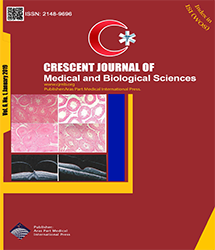
| Original Article | |
| The Relationship Between Temperament and Primary Dysmenorrhea From Persian Medicine Point of View | |
| Farrin Rajabzadeh1, Seyyed Mohammad bagher Fazljou1, Laleh Khodaie2, Leyla Sahebi3, Shamsi Abbasalizadeh4, Shahla Hemmatzadeh5 | |
| 1Department of Iranian Traditional Medicine, Tabriz University of Medical Sciences, Tabriz, Iran 2Medical Philosophy and History Research Center, Tabriz University of Medical Sciences, Tabriz, Iran 3Maternal, Fetal and, Neonatal Research Center, Tehran University of Medical Sciences, Tehran, Iran 4Department of Obstetrics and Gynecology, Tabriz University of Medical Sciences, Tabriz, Iran 5Department of Midwifery, Tabriz Branch, Islamic Azad University, Tabriz, Iran |
|
|
CJMB 2019; 6: 115-122 Viewed : 4759 times Downloaded : 3169 times. Keywords : Dysmenorrhea, Temperament, Complementary Therapies, Nature |
|
| Full Text(PDF) | Related Articles | |
| Abstract | |
Objectives: Persian medicine (PM) encompasses preventive medicine, as well as disease control and treatment fields. PM believes in the existence of cold and hot natures in humans (Mizaj). A person›s temperament is mostly related to the recognition of the most appropriate diet and way of life in order to promote health. Accordingly, the present study aimed to examine the correlation between uterine temperament and primary dysmenorrhea. Materials and Methods: This research which is a cross-sectional descriptive-correlational study was conducted on 105 students within the age range of 18 to 35 years old who lived in dormitories of Tabriz University of Medical Sciences for 3 months during 2017. These students were selected by random sampling technique. Data were analyzed using the SPSS software, version 24 by the chi-square, biserial rb, and Mann-Whitney tests. Results: The frequency of cold-dry temperament in patients with dysmenorrhea was higher than that of other temperaments (26.2 %). In addition, no significant correlation was found between the intensity of pain and body temperament (P = 0.421) or between the intensity of pain and uterine temperament (P = 0.508). However, there was a meaningful relationship between the duration of pain and body temperament (P = 0.049) and between the duration of pain and uterine temperament (P = 0.027). Conclusions: Generally, the duration of menstrual pain was longer in patients with cold temperament compared to those with hot temperament. Accordingly, adherence to traditional Iranian medicine recommendations in dealing with cold temperament can be effective in reducing the duration of pain in these patients. |
Cite By, Google Scholar
Google Scholar
PubMed
Online Submission System
 CJMB ENDNOTE ® Style
CJMB ENDNOTE ® Style
 Tutorials
Tutorials
 Publication Charge
Medical and Biological Research Center
About Journal
Publication Charge
Medical and Biological Research Center
About Journal
Aras Part Medical International Press Editor-in-Chief
Arash Khaki
Deputy Editor
Zafer Akan


















